Notice: Undefined variable: page in /home/vrxdg1855sn3/public_html/wp-content/themes/72tree/content.php on line 15
Notice: Trying to get property 'ID' of non-object in /home/vrxdg1855sn3/public_html/wp-content/themes/72tree/content.php on line 15
3 Evergreen Tree Species for Your Alpharetta and Roswell Yard
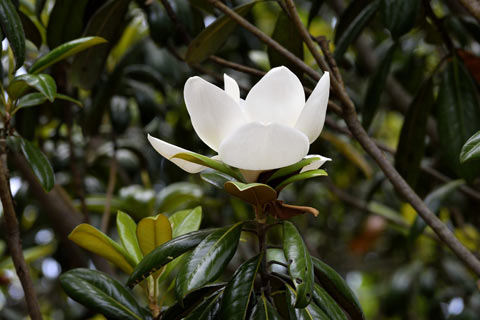
The difference between evergreen trees and deciduous trees becomes very obvious in the fall. Evergreens stay green and keep their foliage, while deciduous trees typically change the color of their leaves before dropping them and going dormant.
Evergreen trees do drop foliage, just not all at once. Throughout the year, they will drop small portions of their foliage and grow it back. These trees do not experience a dormant period like their deciduous counterparts, but they do slow down in the winter months.
For those with an aversion to raking up leaves in the fall, the arborist at 72tree.com identified 3 evergreen tree species to enhance your Alpharetta and Roswell Ga landscape.
Pine Trees
Of the North American native tree species, pine trees are one of the most widely spread and varied classes. Because of their ability to adapt and the ease to care for them, pines remain very popular landscaping trees from coast to coast.
Height – Within the pine family, some of the species can reach an astounding 150 feet tall and live to be more than 450 years old.
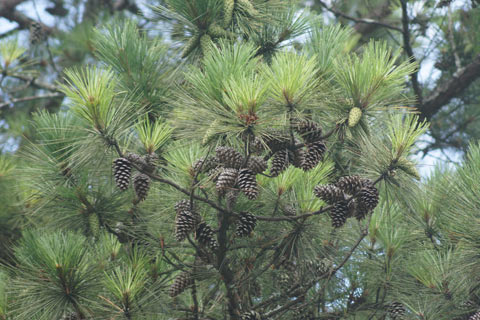
Crown Width – Mature pine tree canopies can stretch from 15 t0 30 feet in diameter depending on the species and the environment it is planted in.
DBH – When pines such as these reach maturity, their trunk DBH (diameter at breast height) can measure from 2.5 to 4 feet. As with most trees, there is just as much happening below ground.
Root System – As pines develop an extensive, deep, expansive, and invasive root system, they should not be planted within 20 feet of permanent structures like fences, underground utility lines, or homes.
Pest Problems – Bark beetles, aphids, and bagworms are a few of the pests that enjoy making a meal of pine trees. Mites and tree scale are also likely.
Disease – Some of the more common diseases that affect pine trees are needlecast, root rot, and pine wilt.
Pesticides and fungicides can be used to curb the progress of these pests and diseases. However, in cases of severe infestation and infection, an arborist should be called to evaluate the tree and what actions should be taken (including the tree’s removal if necessary).
Magnolia Trees
This classic Southern beauty (magnolia grandiflora) is very distinctive with its wide glossy leaves and enormous fragrant white blossoms. When it comes to year-round beauty, there are few trees that can keep up with it.

Its full luxurious look has made it a popular ornamental around the world.
This tree, although evergreen will drop leaves throughout the year. Growing anything beneath this tree (including grass) is difficult due to its dense foliage casting full shade and its shallow roots.
Height – A magnolia tree planted in a location with rich soil, little to no obstacles for the root system, and good soil drainage can reach heights of more than 80 feet.
Crown Width – While this tree possesses a pyramidal to rounded crown at the top, its width can reach 30 to 40 feet at the base and mid section.
DBH – Adult magnolias can reach a DBH of 24 to 36 inches. To reach this size takes anywhere from 80 to 100 years.
Root System – The species itself is a deep rooted one. First to develop is a strong tap root, then as the tree grows, many sunken roots will grow down from the root collar, and as the tree ages, major lateral roots will grow. When planted in areas with a high water table, the roots will grow more shallow and outward.
The optimum soil for this species is a rich, well drained, and slightly acidic one. When planting a magnolia, add generous amounts of organic material to the soil for the best growing conditions.
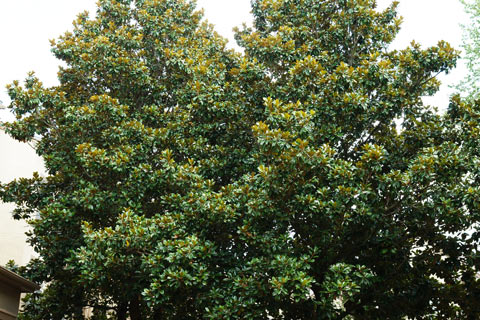
Although magnolia roots are not considered invasive, when planted too close to sidewalks or foundations, they will eventually cause undesired cracking and buckling.
Pest Problems – Varieties of scale, aphids, striped mealybug, spider mites, and magnolia leafminers are all potential infestation culprits.
Disease – There are a number of fungi which cause leaf spots. For the most part, they are unable to cause any significant damage to adult magnolias.
As well, there are a number of Polyporus fungi and Fomes which can cause heart rot.
Again, pesticides and fungicides can be used to curb the progress of these pests and diseases. When a severe infestation or infection is detected, an arborist should be called to assess what actions should be taken.
Eucalyptus Trees
Of all of the evergreen trees you could want in your yard, eucalyptus should be at or near the top of the list. This species is a fast growing, insect repelling, and gorgeous tree that adds beauty and practicality to whatever landscape it grows in.
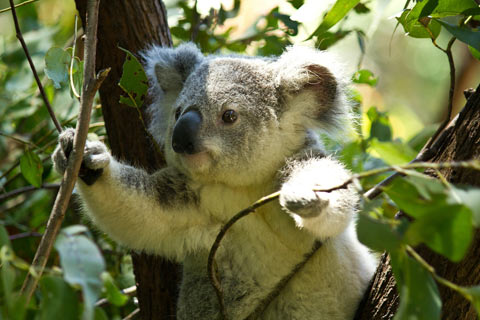
For most, the image you get when you hear “eucalyptus” is a koala bear latched on to a branch, munching away at the leaves. You may be surprised to learn that only the koala, some possum species, and a select few insects are actually able to consume parts of this species. In large quantities, this tree’s secret weapon (cineole) is toxic.
It is the cineole aka: eucalyptol in eucalyptus trees that make up the greatest part of its signature aroma. Eucalyptus essential oil has been used for centuries in the treatment of respiratory ailments, as a disinfectant, and as an antibacterial or anti-fungal agent in medicine.
Height – Eucalyptus tree sizes vary. Their height at maturity can range from 30 to 35 feet for smaller varieties all the way to over 200 feet for the tallest of the species.
These trees must be planted away from physical structures. Mature eucalyptus trees are known to unexpectedly drop branches.
Crown Width – The eucalyptus tree species will typically grow tall and relatively slender, with mature crowns reaching from 12 to 30 feet in diameter. Many varieties of the species are able to reach much greater diameters as they age.
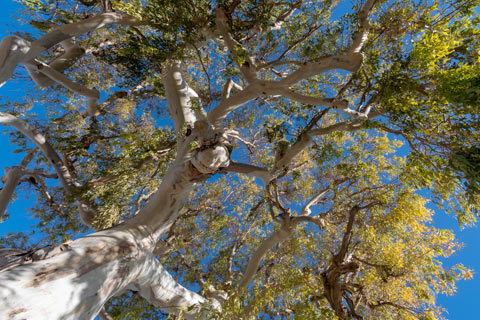
DBH – Adult eucalyptus trees can reach a DBH of 15 to 20 inches.
It is worth mentioning that this species is able to reach maturity within 10 years of growth. That’s less than half (in some cases less than a third) of the time it takes for the majority of other species to reach maturity.
Root System – This species quickly adapts to the soil it is planted in. In rich, fertile soil, the roots have no need to go deep. The tree is on a fast track for height and the roots will spread horizontally staying close to the surface.
In more nutrient deprived soil, the roots will dive deep for their food and moisture source. Counterintuitively, it is the eucalyptus planted in poor soil that grows to be the more stable and wind or storm resistant.
Pest Problems – Little to none (as long as the tree remains healthy). High concentrations of cineole in all parts of eucalyptus trees acts a natural insect repellant.
Two species of Australian tortoise beetles (family Chrysomelidae) (still isolated in the west) chew semicircular holes or notches on edges of eucalyptus leaves.
These beetles are able to remove most of a leaf’s surface, leaving only the midvein.The damage caused by these beetles is unsightly but not life threatening to the tree.
If a tree is stressed enough, an opportunity opens up for the eucalyptus longhorn borer. The female of this species lays her eggs on stressed trees, producing larvae that burrow their way to the cambium layer.
A heavily infested tree can die within weeks, which is due to the larval galleries girdling the tree and disrupting the flow of water and nutrients.
Infestations must be treated immediately. Because of the speed at which death can occur, an arborist should be called to evaluate the tree and determine what actions to take.
Disease – Canker, heart rot, and Phytophthora can infect a stressed eucalyptus tree. All three of these fungi attack and damage the tree from the inside.
Signs of infection are discolored leaves and in severe cases, splitting of the trunk. In any of these cases, the tree should be removed, destroyed (burned) and all equipment disinfected to prevent the disease from spreading to other trees.
Tree Care for Evergreens
As long as evergreens are planted in hardiness zones where they can thrive and get ample summer sunlight and winter shade (possibly on the north side of your property), caring for these trees is relatively simple.
Water them regularly and mulch around their trunk. This will keep them strong and winter injury resistant. Evergreens (when not mulched or watered well) can be severely injured by the drying effects of the sun and wind through winter months.
A major benefit of evergreens in your yard is that there is no bad season. Even during the coldest days of winter, your landscape will be filled with full, and vibrantly-green trees.
Sources:
http://ipm.ucanr.edu/PMG/PESTNOTES/pn74104.html
http://homeguides.sfgate.com/care-maintenance-evergreen-trees-59096.html
https://en.wikipedia.org/wiki/Salix_babylonica#Horticultural_selections_and_related_hybrids
https://gardenerdy.com/types-of-evergreen-trees
https://www.ambientbp.com/blog/7-facts-eucalyptus-trees
Notice: Undefined variable: page in /home/vrxdg1855sn3/public_html/wp-content/themes/72tree/content.php on line 15
Notice: Trying to get property 'ID' of non-object in /home/vrxdg1855sn3/public_html/wp-content/themes/72tree/content.php on line 15
4 Shrub Species for Your Alpharetta Georgia Yard
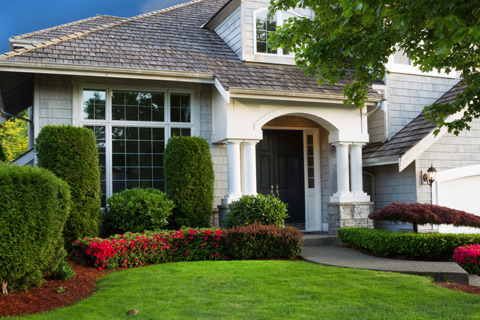
Trees, flowering shrubs, bushes, plants, and grass all work together to create a diverse ecosystem above and below the ground. While birds, insects, and other wildlife are attracted to the foliage, refuge, and blooms above, the roots are working below to find water, nutrients, and stability.
Choosing the right shrubs for your Alpharetta Ga landscape is a question of selecting ones that will thrive in the conditions of the environment where they are planted.
The team at 72tree.com has identified 4 shrub specimens that will enhance the natural beauty of your Alpharetta yard and landscape.
Hardiness Zone 7b Bushes and Shrubs for Alpharetta
The USDA Hardiness Zone Map divides North America into 11 planting zones. Each individual planting zone is around 10°F colder (or warmer) than its neighboring zone –during an average winter.
At your local nursery or garden supply store, plant identification tags usually identify the zone in which that species will thrive.
The city of Alpharetta is located in zone 7b with a humid subtropical climate which supports the following striking species:
Juniper – juniperus
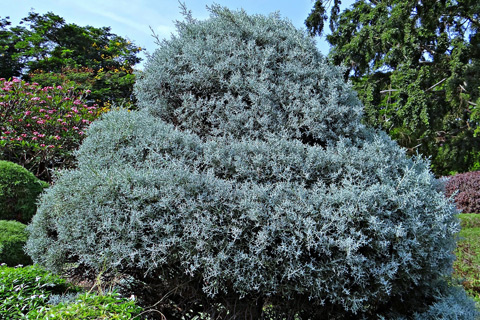
Junipers are long lived, slow growers, and rarely die. With a strong and extensive root system, they are able to adapt to their surrounding environment with ease. When planted in a location with ample space for growth, this specimen requires very little attention.
Juniper varieties vary in shape and size. The taller of the species can reach heights of more than 130 feet at maturity. The majority of the species however, are slow growing and will only reach about 30 feet in height, or 3 feet in diameter at maturity.
Junipers are evergreen and while they do not produce flowers or fruit, they do produce seeds.
Under the right conditions, this species can live from 400 to 700 years.
They are vulnerable to rust disease, which can be managed through pruning affected areas and treating them with fungicides.
Mountain Laurel – Kalmia latifolia
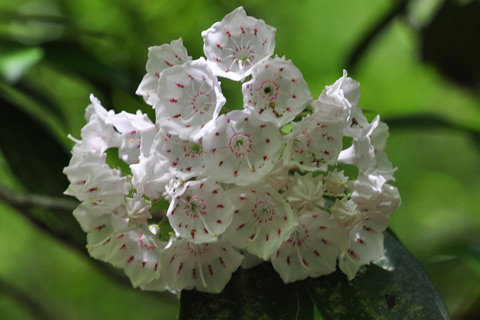
Mountain Laurels are relatively fast growers when properly planted. With a matted spreading root system, this shrub grows well in acidic well drained soil, and thrives when grown on north facing slopes or the east side of structures.
Mountain Laurel varieties are able to reach upwards of 25 feet, and if left to thrive without pruning, can grow into a large blooming thicket. Prolonged direct sunlight in summer months can stress this species. Take this into consideration when choosing its location.
This species is evergreen and produces flowers in terminal trusses of 50 to 150 blooms. Blooms range in color from white to pink and deep rose commonly with purple details. Flowering occurs in late spring (May and June).
This shrub however, is toxic. All of the green components – including the flowers, pollen, and twigs – contain andromedotoxin and is poisonous when ingested. If browsing animals consume enough of the plant, it can be lethal.
Mountain Laurel is vulnerable to leaf spot which can be managed through pruning affected areas and then treated with fungicides.
Rose of Sharon – Hibiscus Syriacus
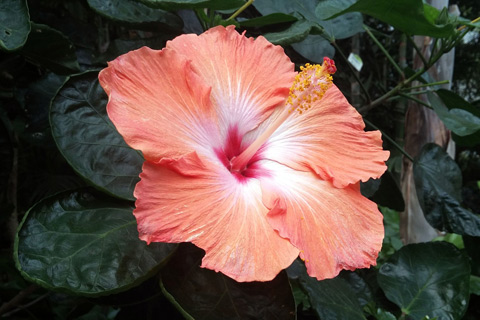
Rose of Sharon can be planted as a small tree or large shrub. It grows well in varied soil types but performs best in hot climates with moist soil and full sun.
At maturity, this species can reach up to 12 feet tall and grow 10 feet wide. Being multi-stemmed with vertical branches, it is relatively easy to grow, and requires minimal care. For this trait, Rose of Sharon is commonly used as hedging.
Rose of Sharon is a deciduous flowering shrub which with heavy pruning in early spring promotes flowering from July through September. Its flowers reach 2 to 4 inches in width, and blooms can range in color from pink, red, purple, white, and blue with a typically red center.
This species, if left unchecked, will reproduce and spread quickly in areas with little disturbance. Rose of Sharon is a vigorous and healthy species with high tolerance to pests and disease. When there is a problem with either, it is easily remedied through heavy pruning and with insecticides or fungicides.
Gardenia – Gardenia jasminoides
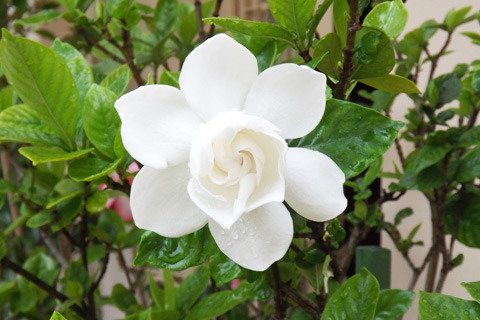
Gardenia can be planted as a small tree or large shrub. It thrives in acidic soil with good drainage, and flourishes in high humidity. This shrub grows best with night temperatures above 60 degrees, and mid to low 70’s during the day. Bright (not direct) sunlight is best for this species.
This shrub can typically grow up to 15 feet but some varieties are able to reach heights of 50 feet tall. With its many size and form variations, they are frequently used as hedges, ground cover, and even specimen plantings.
Gardenias are evergreen flowering shrubs and small trees that do require moderate attention and care. Flowering from April through July, the flowers can be solitary or in clusters; they range in color from white to pale yellow.
One of the greatest features of growing gardenias is its sweet scent. Once the species blooms however, the flowers quickly wilt when they come in contact with water.
Gardenias are highly susceptible to pest infestations. However, they can be easily managed with insecticidal soaps or horticultural oils. It also helps to maintain a high level of biodiversity in your garden which serves to attract predators of the insects threatening your garden.
Benefits of Shrubs Around Trees
Besides all of the artistic possibilities that come about on a landscape rich with trees and shrubs, during severe weather and strong winds, it is your shrubs and bushes that act as a wind buffer.
Shrubs and bushes do an excellent job at diverting wind, thus weakening it. This in turn spares the surrounding trees from taking the full force of potentially damaging winds.
Likewise, the bushes planted around your home will help shield it when the cold winter winds begin to blow.
Healthy Gardens and Landscapes Need Diversity
A healthy garden and landscape will have a variety of thriving tree, plant, and shrub species. Throughout the blooming season, as each species flowers, it attracts different insects and wildlife.
This biodiversity helps to stave off infestations. Likewise, the co-mingling of roots and fungi (in fertile soil) help to create a thriving mycorrhizal network below the soil that works to impede invasive diseases.
Remember to have a plan in mind when acquiring plants and shrubs for your garden and landscape. Not all shrubs can be planted equally, but they all can thrive in the right environment.
Sources:
http://buckjones.com/trees-shrubs-how-to-choose/
https://www.michigandnr.com/publications/pdfs/huntingwildlifehabitat/Landowners_Guide/Resource_Dir/Acrobat/Trees_and_Shrubs.PDF
http://www.lot-lines.com/5-reasons-to-reconsider-your-hatred-of-juniper-bushes/
https://en.wikipedia.org/wiki/Kalmia_latifolia
https://extension.psu.edu/mountain-laurel-diseases
https://www.uaex.edu/yard-garden/resource-library/plant-week/mountain-laurel-6-15-12.aspx
http://www.hort.uconn.edu/plants/detail.php?pid=204
https://communityenvironment.unl.edu/plant-month-rose-sharon
http://homeguides.sfgate.com/rose-sharon-tree-41486.html
http://gardeningsolutions.ifas.ufl.edu/plants/ornamentals/gardenias.html
https://en.wikipedia.org/wiki/Gardenia
https://plants.ces.ncsu.edu/plants/all/gardenia-augusta-g-jasminoides/
Notice: Undefined variable: page in /home/vrxdg1855sn3/public_html/wp-content/themes/72tree/content.php on line 15
Notice: Trying to get property 'ID' of non-object in /home/vrxdg1855sn3/public_html/wp-content/themes/72tree/content.php on line 15
Signs of a Diseased Tree – Dieback, Tree Suckers & Water Sprouts
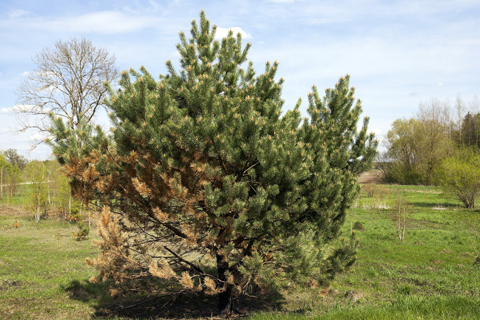 Spruce with dieback needs tree care to preserve healthy landscape.
Spruce with dieback needs tree care to preserve healthy landscape.
Many diverse diseases affect your landscape, shrubs and trees. Identifying these diseases is critical because, not all tree diseases can be controlled. We love to watch things grow when we garden but we must note that not all growth is positive or advantageous to the trees. Some of these growths take energy away from the tree; common examples include water sprouts and suckers. At 72tree.com we often see the damaging effects of tree disease, and in this article, dieback, tree suckers and water sprouts are the disorders we’ll be discussing.
Dieback of a Tree or Its Limbs
In spring as the weather gets warmer, and buds start noticeably leafing out, you might notice that a section or even an entire limb is not leafing out consistent with the rest of the tree. Dieback is a condition in which the ends of the tree branches die. These sections are generally located at the limb tips, but can also be entire limbs or sections of the tree where there will be no leaves. Most times, this is a sign that all is not right with the tree.
Water Sprouts Due to Branch Removal
Water sprouts are dynamic shoots that develop from dormant buds either on large branches or trunks of a tree. They are usually upright and in many cases occur as a result of the removal or trimming of large branches. Heavy pruning may also lead to the production of more sprouts. Tree stress may also result in water sprout growth, but it’s not usually as vibrant as those that occur due to pruning.
Trees should be checked regularly. If you notice new shoots, eliminate them by rubbing them off as they emerge. Large water sprouts can be pruned off close to the trees trunk. Water sprouts can ruin a tree’s shape and they also divert the tree’s energy by blocking air circulation and light. Though not advised, some allow sprouts to grow in the place of missing branches, but it may lead to a reduction in quality of the tree’s ability to bear more fruits. Also, water sprouts are more inclined to promote tears, disease and breaks, as they are generally weaker than other branches.
Tree Suckers
Suckers are un-planned, vegetative growths that stem from a tree’s root system. Suckers grow from rootstock and divert nutrients away from the trees top growth. There isn’t any actual benefit from letting suckers grow because, rootstocks are usually different from the type of tree that you planted (example – a Gala apple tree will not have a Gala apple rootstock).
To find and cut from the base of a sucker, you may have to pull back any ground cover and dig up some soil to fully expose the sucker. Ensure that as much growth as possible is removed to reduce the potential of them popping up again. If they do re-emerge, this simple process will have to be repeated. Although suckers and water sprouts are similar, remember suckers originate from the root or base of the tree.
Tree Disease Prevention and Care
You might be able to deal with a disease that occurs on your trees and shrubs but you ought to consider consulting a local arborist or tree service professional if you are uncertain. The arborist will identify any disease and offer you the best treatment options and the ideal time to care for the tree.
Early spring (during most maintenance pruning) is the best time to remove both water sprouts and tree suckers. However, these unwanted growths sometimes sprout and occur during the growing season, they should be removed as soon as you notice their existence. Your trees will thank you and be fruitful!
